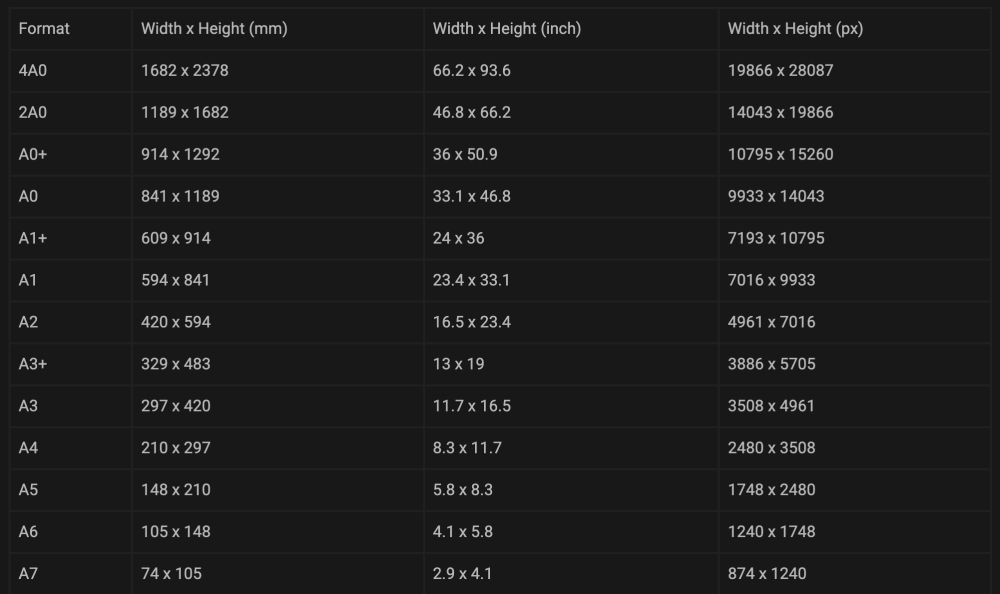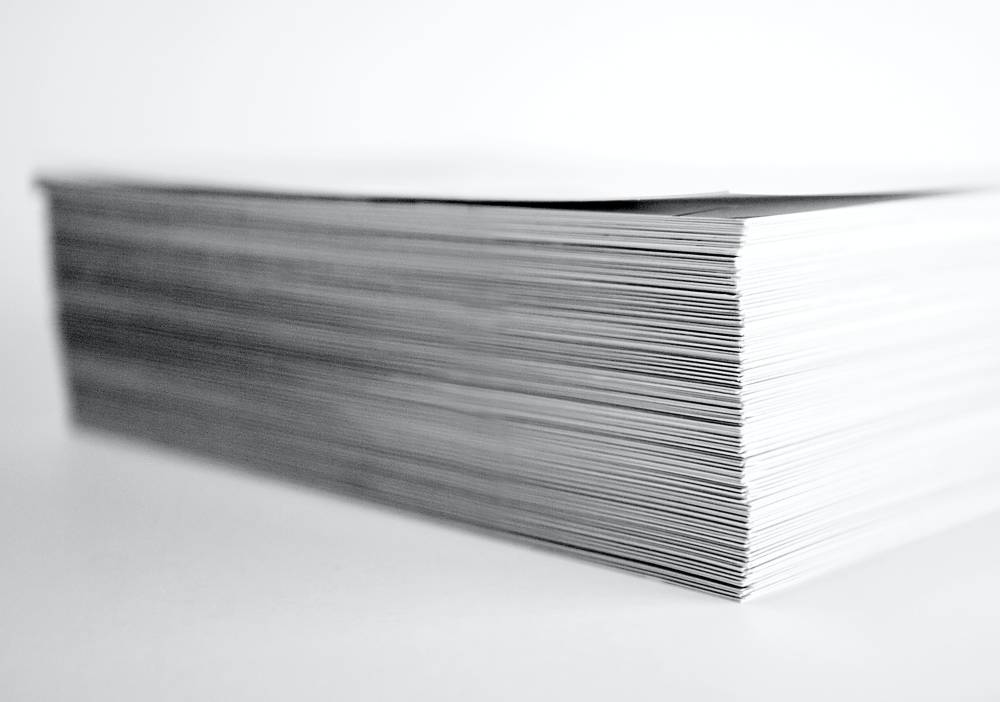Paper sizes play a crucial role in various industries, from printing and graphic design to office documentation and communication. Choosing the right paper size is essential to ensure the success of your projects. In this comprehensive guide, we will explore the world of standard paper sizes, their origins, and their uses in different contexts.
Table of Contents
- Introduction
- The Evolution of Paper Sizes
- ISO 216: The International Standard
- The A Series: From 4A0 to A13
- The B Series: A Companion to the A Series
- The C Series: Envelopes and More
- The North American System
- Printing A4 Documents on Letter and Vice Versa
- Untrimmed Paper Pages: Bleed and Margins
- Why Are These Sizes the Standard?
1. Introduction
When it comes to paper sizes, there are numerous options available, but standard sizes have emerged as the most widely used and accepted. These standard sizes ensure compatibility across different devices, printers, and applications. Understanding and using standard paper sizes can save you time, money, and headaches in your professional and personal projects.
2. The Evolution of Paper Sizes
Over time, paper sizes have evolved and adapted to meet the needs of different industries and geographical regions. The origins of standardized paper sizes can be traced back to the 18th century when German scientist Georg Christoph Lichtenberg proposed the concept of an aspect ratio equal to the square root of two. This idea formed the basis for the ISO 216 standard, which is widely used today.
3. ISO 216: The International Standard
The ISO 216 standard is the international benchmark for paper sizes. It is characterized by an aspect ratio of the square root of two, which ensures that each subsequent size can be obtained by halving the larger size. The most common series within the ISO 216 standard is the A series, which includes sizes ranging from 4A0 to A13.
3.1 The A Series: From 4A0 to A13 and more
The A series is the most widely used and recognized series of paper sizes. It starts with 4A0, the largest size, and goes all the way down to A13, the smallest. Each size in the A series is obtained by halving the larger size, while maintaining the same aspect ratio. The A4 size, measuring 210 x 297 mm (8.3 x 11.7 inches), is the most commonly used size for general printing purposes.
| Format | Width x Height (mm) | Width x Height (inch) | Width x Height (px) |
|---|---|---|---|
| 4A0 | 1682 x 2378 | 66.2 x 93.6 | 19866 x 28087 |
| 2A0 | 1189 x 1682 | 46.8 x 66.2 | 14043 x 19866 |
| A0+ | 914 x 1292 | 36 x 50.9 | 10795 x 15260 |
| A0 | 841 x 1189 | 33.1 x 46.8 | 9933 x 14043 |
| A1+ | 609 x 914 | 24 x 36 | 7193 x 10795 |
| A1 | 594 x 841 | 23.4 x 33.1 | 7016 x 9933 |
| A2 | 420 x 594 | 16.5 x 23.4 | 4961 x 7016 |
| A3+ | 329 x 483 | 13 x 19 | 3886 x 5705 |
| A3 | 297 x 420 | 11.7 x 16.5 | 3508 x 4961 |
| A4 | 210 x 297 | 8.3 x 11.7 | 2480 x 3508 |
| A5 | 148 x 210 | 5.8 x 8.3 | 1748 x 2480 |
| A6 | 105 x 148 | 4.1 x 5.8 | 1240 x 1748 |
| A7 | 74 x 105 | 2.9 x 4.1 | 874 x 1240 |
| A8 | 52 x 74 | 2 x 2.9 | 614 x 874 |
| A9 | 37 x 52 | 1.5 x 2 | 437 x 614 |
| A10 | 26 x 37 | 1 x 1.5 | 307 x 437 |
| A11 | 18 x 26 | 0.7 x 1 | 213 x 307 |
| A12 | 13 x 18 | 0.5 x 0.7 | 154 x 213 |
| A13 | 9 x 13 | 0.4 x 0.5 | 106 x 154 |
3.2 The B Series: A Companion to the A Series
The B series of paper sizes is a companion to the A series, providing a wider range of options. The B sizes have slightly larger dimensions than their corresponding A sizes. For example, B4 is larger than A3, and B5 is larger than A4. The B series is often used in printing and design to accommodate two A series sheets side by side.
| Format | Width x Height (mm) | Width x Height (inch) | Width x Height (px) |
|---|---|---|---|
| B0+ | 1118 x 1580 | 44 x 62.2 | 13205 x 18661 |
| B0 | 1000 x 1414 | 39.4 x 55.7 | 11811 x 16701 |
| B1+ | 720 x 1020 | 28.3 x 40.2 | 8504 x 12047 |
| B1 | 707 x 1000 | 27.8 x 39.4 | 8350 x 11811 |
| B2+ | 520 x 720 | 20.5 x 28.3 | 6142 x 8504 |
| B2 | 500 x 707 | 19.7 x 27.8 | 5906 x 8350 |
| B3 | 353 x 500 | 13.9 x 19.7 | 4169 x 5906 |
| B4 | 250 x 353 | 9.8 x 13.9 | 2953 x 4169 |
| B5 | 176 x 250 | 6.9 x 9.8 | 2079 x 2953 |
| B6 | 125 x 176 | 4.9 x 6.9 | 1476 x 2079 |
| B7 | 88 x 125 | 3.5 x 4.9 | 1039 x 1476 |
| B8 | 62 x 88 | 2.4 x 3.5 | 732 x 1039 |
| B9 | 44 x 62 | 1.7 x 2.4 | 520 x 732 |
| B10 | 31 x 44 | 1.2 x 1.7 | 366 x 520 |
| B11 | 22 x 31 | 0.9 x 1.2 | 260 x 366 |
| B12 | 15 x 22 | 0.6 x 0.9 | 177 x 260 |
| B13 | 11 x 15 | 0.4 x 0.6 | 130 x 177 |
3.3 The C Series: Envelopes and More
The C series of paper sizes is primarily used for envelopes. The sizes in the C series are designed to fit their corresponding A series sheets without the need for folding. For example, a C4 envelope can easily fit an unfolded A4 sheet. The C series provides a convenient and standardized solution for mailing and packaging needs.
| Format | Width x Height (mm) | Width x Height (inch) | Width x Height (px) |
|---|---|---|---|
| C0 | 917 x 1297 | 36.1 x 51.1 | 10831 x 15319 |
| C1 | 648 x 917 | 25.5 x 36.1 | 7654 x 10831 |
| C2 | 458 x 648 | 18 x 25.5 | 5409 x 7654 |
| C3 | 324 x 458 | 12.8 x 18 | 3827 x 5409 |
| C4 | 229 x 324 | 9 x 12.8 | 2705 x 3827 |
| C5 | 162 x 229 | 6.4 x 9 | 1913 x 2705 |
| C6 | 114 x 162 | 4.5 x 6.4 | 1346 x 1913 |
| C7 | 81 x 114 | 3.2 x 4.5 | 957 x 1346 |
| C8 | 57 x 81 | 2.2 x 3.2 | 673 x 957 |
| C9 | 40 x 57 | 1.6 x 2.2 | 472 x 673 |
| C10 | 28 x 40 | 1.1 x 1.6 | 331 x 472 |
4. The North American System
In North America, a different paper size system is used, primarily in the United States and Canada. The North American system is based on traditional sizes such as Letter (8.5 x 11 inches) and Legal (8.5 x 14 inches). While these sizes are widely used in the region, they do not follow the same aspect ratio as the ISO 216 standard.
| Format | Width x Height (mm) | Width x Height (inch) | Width x Height (px) |
|---|---|---|---|
| Ledger | 432 x 279 | 17 x 11 | 5102 x 3295 |
| Tabloid | 279 x 432 | 11 x 17 | 3295 x 5102 |
| Letter | 216 x 279 | 8.5 x 11 | 2551 x 3295 |
| Government - Legal | 216 x 330 | 8.5 x 13 | 2551 x 3898 |
| Legal | 216 x 356 | 8.5 x 14 | 2551 x 4205 |
| Government - Letter | 203 x 267 | 8 x 10.5 | 2398 x 3154 |
| Half Letter | 140 x 216 | 5.5 x 8.5 | 1654 x 2551 |
| Junior Legal | 127 x 203 | 5 x 8 | 1500 x 2398 |
5. Printing A4 Documents on Letter and Vice Versa
One common challenge when working with paper sizes is printing documents designed for one standard on another standard. For example, printing an A4 document on Letter-sized paper or vice versa. While the size difference may seem minimal, it can affect the layout and formatting of the document. It is important to adjust the print settings and ensure compatibility between the document size and the paper size.
6. Untrimmed Paper Pages: Bleed and Margins
When designing printed materials, it is essential to consider the concept of untrimmed paper pages. Untrimmed pages include additional space beyond the final desired size of the document. This additional space, known as the bleed, allows for slight variations during the printing and trimming process. Properly incorporating bleed and margins into your designs ensures that important elements are not cut off and that the final printed product looks professional.
7. Why Are These Sizes the Standard?
The standardization of paper sizes has been driven by the need for compatibility and efficiency in various industries. Standard sizes allow for easy interchangeability, printing, and distribution of documents. They also provide a common reference point for designers, printers, and users. The adoption of standard sizes simplifies processes, reduces costs, and ensures consistency in the production and use of paper-based materials.
In conclusion, standard paper sizes are essential for efficient communication, printing, and design. Understanding the different series, such as the ISO A, B, and C series, as well as the North American sizes, allows for seamless integration of paper-based materials. Whether you are printing a document, designing a brochure, or mailing an envelope, standard paper sizes provide a reliable and consistent framework to work within.
References:
Paper Sizes - The Ultimate Guide
Paper Sizes and Formats Explained
Understanding Printer Paper Sizes Made Easy



